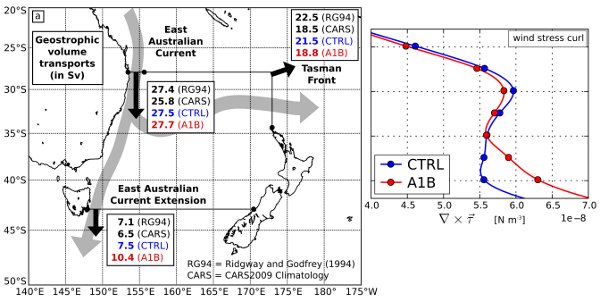|
Extending our understanding of South Pacific gyre 'spin-up': Modeling the East Australian Current in a future climate (Oliver and Holbrook, Journal of Geophysical Research, 2014) Abstract: The western Tasman Sea represents a global warming marine ‘‘hot spot,’’ where the waters are warming at almost 4 times the global average rate, argued in the literature to be due to a ‘‘spin-up’’ of the South Pacific subtropical gyre and extension of the East Australian Current (EAC). To further investigate and test this paradigm, Oliver and Holbrook (Journal of Geophsyical Research, 2014) analyze climate change simulations of Tasman Sea circulation and metrics on output from the Ocean Forecasting Australia Model for the 20th and 21st centuries, forced by a global climate model simulation under the A1B carbon emissions scenario. First, we show that the 1990s simulation estimates of mean dynamic topography, present-day location of the EAC separation point, and volume transports of the EAC, EAC extension, and flow along the Tasman Front, are consistent with recent observations. We further demonstrate that between the 1990s and 2060s, the volume transport of the EAC extension is projected to increase by 4.3 Sv at the expense of the flow along the Tasman Front (projected to decrease by 2.7 Sv). The transport of the EAC core flow (equatorward of the separation point) is projected to change very little (increase of 0.2 Sv). The model projects a Tasman Sea-wide warming, with mean increases of up to 3 degrees C. These results are interpreted using a simple linear, barotropic model which captures both the sign and meridional distribution of the projected changes in mean transport, including negligible change in core EAC transport but enhanced EAC extension. This meridional asymmetry in the transports is consistent with the wind-forced ocean response to changes in the basin-wide wind stress curl.
Projected changes to Tasman Sea eddies in a future climate (Oliver et al., Journal of Geophysical Research, 2015) Abstract: The Tasman Sea is a hot spot of ocean warming, that is linked to the increased poleward influence of the East Australian Current (EAC) over recent decades. Specifically, the EAC produces mesoscale eddies which have significant impacts on the physical, chemical, and biological properties of the Tasman Sea. To effectively consider and explain potential eddy changes in the next 50 years, we use high-resolution dynamically downscaled climate change simulations to characterize the projected future marine climate and mesoscale eddies in the Tasman Sea through the 2060s. We assess changes in the marine climate and the eddy field using bulk statistics and by detecting and tracking individual eddies. We find that the eddy kinetic energy is projected to increase along southeast Australia. In addition, we find that eddies in the projected future climate are composed of a higher proportion of anticyclonic eddies in this region and that these eddies are longer lived and more stable. This amounts to nearly a doubling of eddy-related southward temperature transport in the upper 200 m of the Tasman Sea. These changes are concurrent with increases in baroclinic and barotropic instabilities focused around the EAC separation point. This poleward transport and increase in eddy activity would be expected to also increase the frequency of sudden warming events, including ocean temperature extremes, with potential impacts on marine fisheries, aquaculture, and biodiversity off Tasmania’s east coast, through direct warming or competition/predation from invasive migrating species.
|


